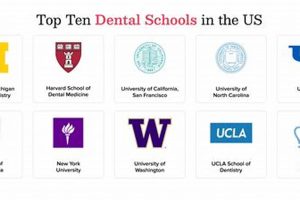Top-tier computer science programs in the United States offer rigorous curricula, cutting-edge research opportunities, and connections to a thriving tech industry. These programs typically feature specializations in areas like artificial intelligence, cybersecurity, data science, and software engineering, providing graduates with a competitive edge in the job market. For instance, a curriculum might include advanced coursework in algorithm design, operating systems, and database management, coupled with hands-on projects and internships.
Access to high-quality education in this field is crucial for driving technological innovation and economic growth. Graduates of leading programs are well-positioned to contribute to advancements in diverse sectors, from healthcare and finance to entertainment and transportation. Historically, American universities have played a pivotal role in shaping the landscape of computer science, and their continued excellence is essential for maintaining global competitiveness.
This article will explore various factors that contribute to a program’s excellence, including faculty expertise, research facilities, industry partnerships, and career outcomes. It will also delve into specific program offerings and highlight unique strengths of different institutions across the country.
Tips for Selecting a Top Computer Science Program
Choosing the right computer science program is a pivotal decision with long-term career implications. Careful consideration of several factors is crucial for identifying the optimal educational path.
Tip 1: Evaluate Faculty Expertise: Investigate the research interests and publications of faculty members. A strong faculty with active research programs can provide valuable mentorship and learning opportunities.
Tip 2: Assess Curriculum Rigor: Examine the coursework offered and look for programs that provide a deep dive into fundamental concepts as well as specialized areas of interest. A balance of theoretical knowledge and practical skills is essential.
Tip 3: Explore Research Opportunities: Look for programs with well-equipped laboratories and opportunities to participate in research projects. Hands-on research experience can significantly enhance learning and career prospects.
Tip 4: Consider Industry Connections: Programs with strong ties to industry offer valuable networking opportunities and pathways to internships and employment. Investigate partnerships with companies and the availability of career services.
Tip 5: Analyze Career Outcomes: Research the career paths of program graduates. Look for data on job placement rates, salary levels, and the types of companies that recruit graduates.
Tip 6: Evaluate Program Location and Culture: Consider the location of the institution and the overall campus environment. Factors like proximity to tech hubs and the presence of a vibrant student community can influence the learning experience.
By carefully considering these factors, prospective students can identify programs that align with their academic and career goals, paving the way for a successful future in computer science.
This information provides a framework for making informed decisions. Further research and self-reflection are encouraged to find the ideal program fit.
1. Faculty Expertise
A key determinant of a top-tier computer science program is the expertise of its faculty. Distinguished professors, active researchers, and industry veterans contribute significantly to the quality of education, research opportunities, and overall prestige of an institution. The depth and breadth of faculty knowledge directly impacts the curriculum, student mentorship, and the institution’s contributions to the field.
- Publication Record and Research Influence
Faculty publications in reputable journals and conferences, as well as citations and h-index metrics, demonstrate their contributions to advancing computer science knowledge. For example, a professor with numerous publications in machine learning demonstrates a deep understanding of the field and can provide students with cutting-edge insights. Institutions with faculty members actively shaping the future of the discipline through research attract top students and foster a vibrant intellectual environment.
- Industry Experience and Connections
Faculty members with prior industry experience bring practical knowledge and real-world perspectives to the classroom. This can include experience at major tech companies, startups, or research labs. These connections can also lead to valuable internship and job opportunities for students. For instance, a professor who has worked on developing operating systems at a major tech company can provide invaluable insights into the challenges and best practices of software development.
- Teaching Excellence and Mentorship
Effective teaching and mentorship are crucial for student success. Faculty who are skilled educators and dedicated mentors can guide students through complex concepts, inspire critical thinking, and foster a passion for learning. Strong mentorship can also help students navigate career paths and connect with industry professionals. A professor who dedicates time to advising students on research projects and career goals plays a vital role in their development.
- Diversity of Specialization
A faculty with diverse specializations across various subfields of computer science, such as artificial intelligence, cybersecurity, and data science, ensures a comprehensive curriculum and allows students to explore a wide range of interests. This breadth of expertise also fosters interdisciplinary research and collaboration. A department with specialists in various areas can offer a more comprehensive educational experience.
These facets of faculty expertise contribute significantly to the reputation and ranking of computer science programs. Institutions with strong faculty attract talented students and researchers, leading to groundbreaking advancements and a thriving academic community. The strength of a program’s faculty is a strong indicator of its ability to prepare students for successful careers in a rapidly evolving technological landscape.
2. Curriculum Breadth
A comprehensive and diverse curriculum is a hallmark of leading computer science programs. Curriculum breadth exposes students to a wide range of sub-disciplines, fostering a holistic understanding of the field and preparing them for diverse career paths. This breadth is a critical factor distinguishing top programs from others, enabling graduates to adapt to the ever-evolving technological landscape.
- Foundational Core Courses
A strong foundation in core concepts like algorithms, data structures, and computer architecture is essential. These foundational courses provide the building blocks for more advanced study and ensure graduates possess the fundamental skills necessary for success in any computer science specialization. For example, a thorough understanding of algorithms is crucial for developing efficient software solutions in any domain.
- Specialized Tracks and Electives
Top programs offer specialized tracks or elective courses that allow students to delve deeper into specific areas of interest, such as artificial intelligence, cybersecurity, or data science. These specialized offerings allow students to tailor their education to their career goals and gain in-depth knowledge in cutting-edge fields. A student interested in cybersecurity could choose electives in cryptography and network security, gaining specialized knowledge in this critical area.
- Interdisciplinary Opportunities
The intersection of computer science with other disciplines is increasingly important. Leading programs offer opportunities for interdisciplinary study, allowing students to explore the application of computer science to fields like bioinformatics, computational finance, or digital humanities. Such interdisciplinary experiences broaden perspectives and prepare graduates for roles in diverse industries. A student interested in bioinformatics could take courses in biology and genomics, combining their computer science knowledge with insights from the life sciences.
- Hands-on Projects and Experiential Learning
Practical experience is crucial for solidifying theoretical knowledge and developing real-world skills. Top programs incorporate hands-on projects, capstone courses, and research opportunities into their curricula. These experiences allow students to apply their knowledge, develop problem-solving skills, and build a portfolio of work to showcase to potential employers. For instance, a capstone project might involve developing a mobile application or designing a machine learning algorithm for a specific application.
The breadth of a computer science curriculum directly impacts the versatility and career prospects of its graduates. Top-ranked programs recognize the importance of a well-rounded education that combines foundational knowledge with specialized skills and practical experience, positioning graduates for success in a dynamic and competitive field. This focus on breadth, coupled with depth in specific areas, sets leading programs apart and contributes to their reputation for producing highly sought-after graduates.
3. Research Opportunities
A strong emphasis on research is a defining characteristic of top computer science programs in the United States. Access to cutting-edge research opportunities significantly enhances a student’s educational experience and contributes to the overall quality and reputation of these institutions. The availability of such opportunities often correlates directly with a program’s ranking and prestige. Engaging in research allows students to contribute to the advancement of knowledge, develop critical thinking skills, and gain practical experience that enhances their career prospects. For instance, a student involved in artificial intelligence research at a leading university might contribute to developing new algorithms for image recognition, gaining valuable experience with cutting-edge technology.
The benefits of research opportunities extend beyond individual student growth. Faculty research activities, often funded by government agencies or industry partnerships, drive innovation and contribute to the broader scientific community. These activities create a dynamic learning environment where students can interact with leading researchers and participate in groundbreaking projects. Institutions with substantial research funding and a culture of innovation attract top faculty and students, further solidifying their position as leaders in the field. For example, universities with dedicated research centers in areas like cybersecurity or quantum computing often attract leading experts and foster collaborations that lead to significant advancements. This concentration of talent and resources creates a fertile ground for innovation and attracts ambitious students seeking to contribute to cutting-edge research.
In summary, research opportunities are integral to defining the best computer science programs. They provide students with invaluable practical experience, foster innovation, and contribute to the overall reputation of an institution. The presence of robust research programs, often evidenced by faculty publications, external funding, and dedicated research facilities, serves as a key indicator of a program’s commitment to academic excellence and its ability to prepare students for leadership roles in the field. This focus on research distinguishes top programs and positions their graduates at the forefront of technological advancement.
4. Industry Connections
Strong industry connections are a hallmark of top computer science programs, distinguishing them from institutions with less engagement with the professional world. These connections provide crucial pathways for students to gain practical experience, secure internships and job placements, and stay abreast of current industry trends. Furthermore, industry partnerships often enrich academic programs through collaborative research projects, guest lectures, and curriculum development informed by real-world needs.
- Internship Programs
Robust internship programs facilitated by established industry partnerships provide students with invaluable real-world experience. Internships at leading tech companies, research labs, or startups allow students to apply their classroom knowledge, develop practical skills, and build professional networks. For example, an internship at a company specializing in artificial intelligence could provide a student with hands-on experience in developing machine learning algorithms, while an internship at a cybersecurity firm might involve analyzing network traffic for potential threats. These experiences not only enhance a student’s resume but also offer insights into various career paths and company cultures.
- Collaborative Research Projects
Partnerships with industry often lead to collaborative research projects that benefit both students and the companies involved. These projects expose students to real-world problems and provide them with the opportunity to contribute to cutting-edge research with practical applications. Companies benefit from access to academic expertise and a pipeline of talented potential employees. For instance, a university might partner with a pharmaceutical company to develop algorithms for drug discovery, providing students with experience in bioinformatics and data analysis while contributing to potentially life-saving research.
- Guest Lectures and Career Workshops
Industry professionals frequently contribute to academic programs through guest lectures, workshops, and career fairs. These events provide students with insights into current industry trends, career advice, and networking opportunities. Hearing directly from experienced professionals allows students to better understand the skills and knowledge required for success in various roles. A guest lecture by a software engineer at a major tech company, for example, could provide students with valuable insights into the software development lifecycle and the challenges of building large-scale systems.
- Curriculum Development and Advisory Boards
Industry input often informs curriculum development, ensuring that academic programs remain relevant and aligned with industry needs. Advisory boards composed of industry leaders provide guidance on curriculum design, emerging technologies, and career preparation. This ensures that graduates possess the skills and knowledge sought by employers, making them highly competitive in the job market. For instance, an advisory board might recommend incorporating coursework on cloud computing or data privacy into the curriculum to reflect the growing importance of these areas in the industry.
These strong industry connections significantly enhance the educational experience and career prospects of computer science graduates. The presence of robust internship programs, collaborative research opportunities, and industry engagement in curriculum development serves as a key indicator of a program’s commitment to preparing students for successful careers in a rapidly evolving technological landscape. This close relationship with the industry is a critical factor that distinguishes the best computer science programs and contributes to their reputation for producing highly sought-after graduates.
5. Resource Availability
Resource availability is a critical factor distinguishing top computer science programs. Ample resources, including state-of-the-art facilities, advanced software, and extensive libraries, directly impact the quality of education and research. Well-equipped laboratories enable students to gain practical experience with cutting-edge technologies, while access to specialized software and datasets facilitates advanced research and project development. For example, access to high-performance computing clusters allows students to work on computationally intensive projects like machine learning and big data analysis, providing experience with resources typically available in industry settings. Furthermore, well-funded departments can attract and retain leading faculty, creating a richer learning environment. Institutions with significant financial investments in their computer science programs demonstrate a commitment to providing students with the best possible educational experience. This commitment to resource provision is a key differentiator among programs and often correlates with higher rankings and prestige. A well-resourced program can offer specialized labs for robotics, virtual reality, or cybersecurity, allowing students to explore diverse areas and gain hands-on experience with specialized equipment.
The impact of resource availability extends beyond the immediate benefits to students. Cutting-edge facilities and equipment enable faculty to conduct groundbreaking research, attracting further funding and enhancing the institution’s reputation. This creates a virtuous cycle where resource availability attracts top talent, leading to further advancements and increased resources. The presence of advanced research facilities, such as dedicated labs for artificial intelligence or quantum computing, not only benefits current students but also attracts prospective students and faculty interested in working at the forefront of their fields. This concentration of resources and talent strengthens the program’s position as a leader in computer science education and research.
In conclusion, resource availability is inextricably linked to the quality and reputation of computer science programs. Adequate funding for facilities, equipment, software, and libraries is essential for attracting and retaining top faculty, supporting cutting-edge research, and providing students with a world-class education. The level of investment in resources often reflects an institution’s commitment to excellence in computer science and serves as a key indicator of its ability to prepare students for successful careers in a rapidly evolving technological landscape. This understanding underscores the importance of considering resource availability when evaluating computer science programs and highlights its connection to the overall success and prestige of an institution.
6. Alumni Network
A robust and engaged alumni network is a significant factor contributing to the distinction of top computer science programs in the United States. This network serves as a valuable resource for current students, providing mentorship, career guidance, and access to a vast professional network. The strength of an alumni network often reflects the quality of the program and its ability to produce successful graduates who remain connected to their alma mater. A strong alumni presence in leading tech companies, research institutions, and startups can significantly enhance a program’s reputation and attract prospective students. For example, a program whose alumni hold leadership positions at major tech companies like Google, Microsoft, or Amazon benefits from increased visibility and prestige within the industry. These alumni often serve as recruiters, mentors, and guest speakers, creating a direct link between the academic program and the professional world. This connection can be particularly valuable for students seeking internships and job opportunities.
The influence of a strong alumni network extends beyond career support. Alumni often contribute to their alma mater through philanthropic donations, supporting research initiatives, scholarships, and facility upgrades. This financial support can significantly enhance a program’s resources and contribute to its long-term success. Furthermore, alumni involvement in advisory boards and mentorship programs provides valuable feedback and guidance, ensuring that the curriculum remains relevant and aligned with industry needs. For instance, alumni working in emerging fields like artificial intelligence or cybersecurity can offer insights into the latest technological advancements and the skills required for success in these areas. This feedback loop helps programs adapt to the ever-evolving technological landscape and ensures that graduates remain competitive in the job market. A university with a dedicated alumni mentorship program can provide students with personalized guidance and support, helping them navigate their career paths and make informed decisions about their future.
In summary, a thriving alumni network is a crucial component of top computer science programs. It provides current students with valuable career support, contributes to the financial well-being of the institution, and ensures the program’s continued relevance in a rapidly changing field. The strength and engagement of the alumni network serve as a powerful indicator of a program’s overall quality and its ability to produce successful graduates who make significant contributions to the field of computer science. Understanding the multifaceted role of the alumni network provides valuable insights into the dynamics of top computer science programs and reinforces the importance of fostering strong connections between current students, alumni, and the broader professional community. This interconnectedness is a defining characteristic of leading programs and contributes significantly to their long-term success and prestige.
Frequently Asked Questions about Top Computer Science Programs
This section addresses common inquiries regarding leading computer science programs in the United States, providing clarity on crucial aspects of program selection and career paths.
Question 1: What factors differentiate top computer science programs from others?
Key differentiators include faculty expertise, research opportunities, curriculum breadth, industry connections, resource availability, and a strong alumni network. Leading programs excel in these areas, offering students a superior educational experience and enhanced career prospects.
Question 2: How important is research experience for undergraduates in computer science?
Research experience is highly valuable, providing practical skills, exposure to cutting-edge technologies, and networking opportunities. It strengthens graduate school applications and enhances career prospects.
Question 3: What role do industry connections play in computer science education?
Industry connections provide crucial internship and job opportunities, inform curriculum development, and offer students insights into current industry trends. Strong industry ties bridge the gap between academia and the professional world.
Question 4: How does program location impact career opportunities in computer science?
Proximity to major tech hubs can increase access to internships, networking events, and job opportunities. However, a strong program with a robust alumni network can connect students to opportunities nationwide.
Question 5: What are the long-term career prospects for graduates of top computer science programs?
Graduates of top programs are highly sought after by leading tech companies, research institutions, and startups. They often command competitive salaries and have diverse career paths available to them.
Question 6: How can prospective students effectively evaluate different computer science programs?
Thorough research is crucial. Prospective students should examine program websites, faculty profiles, curriculum details, research opportunities, and industry partnerships. Attending virtual information sessions and connecting with current students can provide valuable insights.
Careful consideration of these factors will assist prospective students in making informed decisions about their educational pursuits in computer science.
The following section will delve into specific examples of leading computer science programs in the United States, highlighting their unique strengths and offerings.
Best Computer Science Schools in the US
Leading computer science programs in the United States offer exceptional educational opportunities characterized by distinguished faculty, cutting-edge research, comprehensive curricula, and strong industry ties. These institutions cultivate a vibrant learning environment where students gain the theoretical knowledge, practical skills, and professional connections necessary to thrive in a rapidly evolving technological landscape. Factors such as faculty expertise, curriculum breadth, research opportunities, industry connections, available resources, and alumni networks contribute significantly to the overall quality and prestige of these programs. Understanding these key elements is crucial for prospective students seeking to identify programs best suited to their individual aspirations and career goals. The exploration of these factors underscores the multifaceted nature of excellence in computer science education.
The pursuit of excellence in computer science education is essential for driving innovation and addressing complex global challenges. Graduates of top programs are poised to shape the future of technology, contributing to advancements in diverse fields ranging from artificial intelligence and cybersecurity to healthcare and sustainable energy. The continued growth and evolution of these programs are crucial for maintaining global competitiveness and fostering a future powered by technological innovation. Choosing the right program is a pivotal step towards a fulfilling and impactful career in computer science. Further exploration and careful consideration are encouraged to identify the optimal path for individual success.







